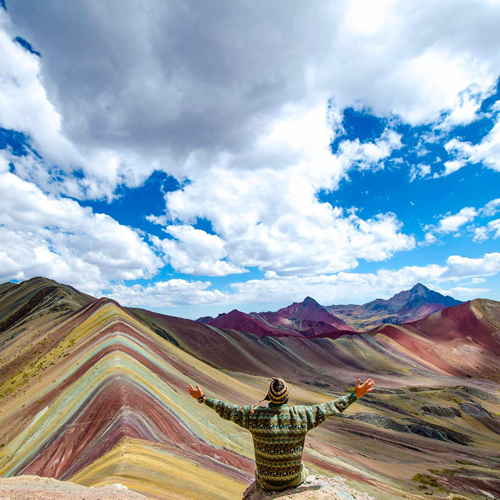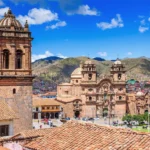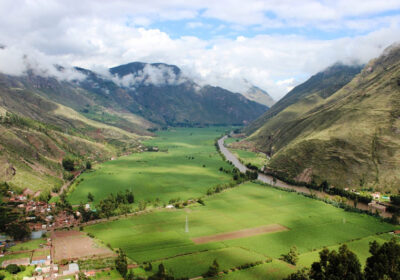
Sacred Valley of the Incas
History of the Sacred Valley of the Incas
The Sacred Valley of the Incas was the source of food for the ancient inhabitants of Cusco and its surroundings. It is a fertile valley that borders the Urubamba River and, protected by the Andean mountains, allowed the Incas to develop abundant potato and corn crops.
Table Of Content
- History of the Sacred Valley of the Incas
- What makes the valley “sacred”?
- Climate and Weather
- Villages of the Sacred Valley
- Pisac
- Ollantaytambo
- Urubamba
- Chinchero
- Tourist ticket
- Travel Tips
- Luggage List
- Altitude Sickness
- Use of money
- Tambo del Inka
- Inkaterra Hacienda Urubamba
- Rio Sagrado, a Belmond Hotel
There they built cities and fortresses with sophisticated architectural techniques that have nothing to envy to those of Machu Picchu: stone blocks fitted together with such precision that they seem immune to the passage of time. Ollantaytambo, for example, is known as the living Inca city, since it still uses the constructions that survived the empire for contemporary purposes. Next to an archaeological park that protects the remains of these buildings, there are others that are used on a daily basis by the local communities. Travelers can walk through its narrow streets and visit its market, where textiles and traditional products from the valley and the nearby jungle are sold. According to some historians, it is the oldest continuously occupied human settlement in South America.
What makes the valley “sacred”?
The Inca named the rivers by sector and called this stretch of the Urubamba “Wilcamayu”, which means “sacred river”. Wilcamayu means “the sacred river”. The Spanish explorers applied this concept to the entire valley, which they called the Sacred Valley. The tourism industry also likes the attractive and evocative name.
A pleasant climate.
The fertile soil and proximity to Cusco made the Urubamba Valley a favourite of the Inca nobility, many of whom are thought to have had their country estates here. Along this valley are Inca remains, ruins and agricultural terraces. Cusco is not the proverbial urban jungle, but by comparison the Sacred Valley offers lower elevations, cooler air, warmer temperatures and rural charm. You could join the growing number of visitors who stay here and make Cusco their day destination, rather than the other way around.
The whole area, although very rural, has good roads and public transport, except to get to the sites of Moray and Salineras. The best option is to hire a car or join a tour.
Climate and Weather
The highland climate of the Sacred Valley has fairly consistent temperatures throughout the year. On high mountain peaks, such as Salkantay, temperatures are cold enough to maintain snow year-round. The climate is much more temperate far down on the valley floor, where cities like Pisac, Urubamba, and Ollantaytambo are located.
Dry season vs. rainy season
Unique to the Andean region of Peru, the Sacred Valley has a dry season and a rainy season.
The dry season lasts from April to October.
During these months there is regular sunshine with a minimal chance of rain.
Temperatures drop significantly at night.
Daytime averages: 68-72°F (20-22°C)
Nighttime Average: 35-40°F (1.7-4.4°C)
The rainy season lasts from November to March.
Cloudy mornings with light showers are typical, and afternoons and evenings can bring heavier rains.
January and February are usually the wettest months.
On average, nighttime temperatures are warmer during the rainy season and colder during the dry season.
Daytime Average: 68-70°F (20-22°C)
Nighttime Average: About 45°F (7.2°C)
Best time to visit
Peak travel season in the Sacred Valley coincides with the dry season: June, July and August. During this time, the weather is usually sunny and conveniently coincides with the summer months for travelers from the northern hemisphere. Due to the high demand for services and limited Machu Picchu train and entrance tickets, it’s best to plan your trip early to ensure specific date availability.
Low season coincides with the region’s rainy season: December, January, February, and March. Rainfall and storms are unpredictable, so flight delays in and out of Cusco are more common. However, there are advantages to traveling during the low rainy season. Places tend to be less crowded, and the mountains of the Sacred Valley are in beautiful shades of green.
Villages of the Sacred Valley
Pisac
Pisac is known for its ruins and market. The road from Cusco to Pisac leads through a mountain pass and drops down into the Sacred Valley. Popular market days in Pisac make the town an obligatory stop. Every Sunday and Thursday, residents from the highland communities sell Andean crafts and freshly grown fruits and vegetables in the main plaza. Keep an eye out for handmade textiles made with natural dyes and one-of-a-kind artisanal pieces. Local tourist-oriented vendors display colorful sweaters and hats made of alpaca wool; silver and stone-embellished jewelry; and ceramic goods.
Ollantaytambo
Ollantaytambo is a small town with big attractions. Shortly after noon, the town turns into a lively hub as the first travelers arrive. After visiting the Inca fortress, you can browse the souvenir shops or relax in a local cafe and admire the Andean scenery surrounding you. There are some very unique and memorable things to do in Ollantaytambo.
The well-preserved archaeological site of Ollantaytambo is built on the slopes of a narrow mountain. Stone steps lead up a terraced hillside to the impressive main complex. The panoramic views at the top are a photographer’s dream!
Urubamba
Although Urubamba has no ancient hillside ruins to boast of, the boutique and luxurious hotels on the outskirts of town attract many travelers. Overnighting in the Urubamba Valley is the perfect way to appreciate the beauty of the Sacred Valley at a more leisurely pace. Enjoy top-notch services, spa facilities and endless Andean views from your room.
For a taste of Urubamba’s budding culinary scene, head to the Q’anela or Paca Paca restaurants. Alma, the restaurant at the Casa Andina Private Collection Hotel in the Sacred Valley, is highly recommended.
Many travelers pass through Urubamba because it is the only road connecting the main transportation routes in the Sacred Valley. In fact, many Sacred Valley tours stop in town for lunch. If you have time to spare, walk to the town square and visit Urubamba’s covered market, just two blocks away.
Chinchero
Life in Chinchero is usually quiet. But on Sundays the town becomes bustling with its popular local market. Vendors offer local, handmade products such as blankets, ponchos, belts and hand-woven rugs. Andean weaving has been practiced in the Sacred Valley for generations, but no town celebrates this centuries-old tradition as much as Chinchero.
Tourist ticket
The Cusco Tourist Ticket includes four sites in the Sacred Valley (Pisac, Chinchero, Moray and Ollantaytambo). The 10-day ticket allows you to visit these four sites and is the only way to get in. It is also possible to purchase a two-day ticket that allows you to visit all four sites in the Valley.

Travel Tips
Luggage List
Clothing. The weather changes quickly in the Sacred Valley, so bring plenty of layers. Pack T-shirts and add warmth with long sleeves and a fleece jacket. Lightweight pants for trekking.
Footwear: Comfortable hiking boots or sneakers with good traction are ideal for hiking to and around the Inca archaeological complexes. If you are hiking for several days, you will definitely want boots with ankle support.
Sun protection. Don’t forget a hat, sunglasses and sunscreen to protect you from the sun.
Day hikes. Bring a daypack with sturdy straps to carry water, camera and other personal items.
Rainy season. During the rainy months, bring a raincoat or travel umbrella. Plastic ponchos are also available in Cuzco and the Sacred Valley.
Altitude Sickness
Altitude sickness is a common health concern for travelers planning to visit the Sacred Valley region. Most visitors experience only mild symptoms (shortness of breath, headache, and nausea) as a result of the altitude. Take it easy during the first few days of acclimatization and do not overexert yourself. The villages of the Sacred Valley are at a lower altitude than Cuzco, so some travelers choose to spend the first few nights in the valley to reduce the symptoms of altitude sickness.
Transportation in the Sacred Valley
Most tours to the Sacred Valley include transportation to and from your hotel. To explore independently, you can take a local bus (the cheapest way) or hire a taxi (more comfortable and time-saving). The train also runs between Cuzco (Poroy train) and Ollantaytambo, in the Sacred Valley, and then up to Aguas Calientes, the town at the foot of Machu Picchu.
Use of money
Peruvian currency (called soles) is used to pay for taxis, small purchases, and tips for guides and porters.
It’s a good idea to carry small bills and coins in the Sacred Valley, as market vendors and small shops may not have enough change to break larger bills.
You’re more likely to get a better exchange rate in Cusco than in small towns in the Sacred Valley. There are ATMs in Pisac, Urubamba, and Ollantaytambo that dispense both US dollars and local currency.
HOTELS
Tambo del Inka
This 5-star luxury hotel in the Sacred Valley has it all: elegant interiors, cozy fireplaces, heated indoor and outdoor pools, and a full spa with treatments inspired by Inca medicine. The 128 well-appointed rooms and suites overlook flowering gardens and feature warm Andean design details and marble bathrooms. After enjoying innovative Andean cuisine at Hawa Restaurant, relax with a cocktail at the Kiri Bar Lounge. Located on the banks of a river, the hotel is within walking distance of Urubamba’s main square and has its own train station with service to Machu Picchu.
Inkaterra Hacienda Urubamba
Inkaterra Hacienda Urubamba is a contemporary hacienda-style hotel located in the Sacred Valley of the Incas, halfway between Cuzco and Machu Picchu. Nestled in the countryside in a beautiful area, the first class hotel covers approximately 100 acres, surrounded by the imposing green mountains of the Sacred Valley. Its 12 rooms and 24 independent luxury casitas offer breathtaking views of the valley, immersing guests in open spaces, tranquillity and relaxing solitude.
Rio Sagrado, a Belmond Hotel
Nestled in a beautiful meadow in the Sacred Valley region of Cusco, this exceptionally luxurious and beautifully appointed 5-star hotel is dedicated to providing guests with the ultimate Cusco experience in the comfort of luxurious surroundings. The junior and deluxe suites feature leather-wrapped beams that replicate 13th-century Inca-style architecture and complement the warmly colored walls of these spacious interiors. The Mayu Wilka Spa offers a full range of therapies and massages, and features a steam room, sauna, and indoor and outdoor Jacuzzi. In the evening, enjoy the delicious menu at El Huerto Restaurant.















No Comment! Be the first one.